Hard rock mining, and the equipment
needed to do it successfully, have gone
hand-in-hand in the Nordic countries for
well over a century. Indeed, some of today’s
leading suppliers of equipment to the
world market can trace their origins back
into the 1800s, as companies that had
been established to service the railway
industry or agriculture diversified their
engineering skills into mining, materials
handling and mineral processing.
Closer to the present, home-grown
expertise in exploration technology and
supplying the need for increasing levels of
mechanization and automation in mining
has provided Swedish and Finnish compa-nies in particular with a huge advantage,
and has given them the opportunity to
compete effectively on the world stage.
Equipment and service companies from
Denmark and Norway are also highly inno-vative, and although mining is not as dom-inant an industry in these countries, their
supply-side sector more than holds its own
internationally.
Some Nordic equipment suppliers—
take Atlas Copco, Sandvik, Outotec, Metso
and FLSmidth as examples—not only have
an international presence, but hold signifi-cant shares of their respective markets
across the globe. From Nordic foundations,
they have expanded through selective
acquisition until their product ranges fulfill
a mine or process plant’s complete needs.
Other companies specialize by providing
niche services or equipment, giving their
customers access to a vast array of mod-ern, competitive tools to help optimize
their operations. From exploration, through
mining to mineral recovery, smelting and
even product transport, companies from
the Nordic countries have a lot to offer.
Mining Machines for Surface and Underground
Loading and Hauling with Volvo CE
Although there is a strong perception that Volvo CE’s machines are for construction,
the company points out that nearly 20% of
its sales are into mining and quarrying. As
an example, the mining contractor at
LKAB’s new Gruvberget operation near
Kiruna uses a fleet of Volvo CE machines,
including 12 wheel loaders, 20 ADTs and
eight hydraulic excavators.
Gruvberget is currently 450 m long by
some 350 m wide and 130 m deep, and
together with LKAB’s future Mertainen and
Leveäniemi mines, will provide around
25% of the company’s total ore by 2015.
The ADT fleet consists mainly of 37-mt-capacity A40D machines, while the largest
excavator on site, an EC700, is in the 70-mt class.
“We run the operation around the clock
throughout the year and handle the loading
of ore and specialty products for LKAB,”
said Ronny Nylund, site manager for
Cliffton, the mining contractor. “Volvo
machines provide a good environment for
the drivers, produce very little noise and
have low fuel consumption,” he added.
“We are very impressed.”
Volvo CE has also reported on another
application for its machines, handling
high-temperature slag at Harsco Metals’
foundry in Mo i Rana, Norway. The L220
loaders move bucketloads of 1,300°C slag
60 m from the furnace tap to a cooling
area, and are fitted with steel plating for
heat protection and reinforced bulletproof
glass in the cab. Volvo CE notes that while
these machines were specially adapted for
this duty, from next year it will be offering
a factory-ready slag-handling version of the
L220G.
Underground Grading
Veekmasis the Nordic countries’ only motor-grader manufacturer, an area of specializa-tion for the company since 1982. It current-ly offers three models specifically designed
for underground use; the FG5 C, FG7 C and
FG15 C, which are powered by 75 kW, 90
kW and 150 kW engines respectively.
Veekmas says its underground graders
are ideal for operating in tight and twisting
mine haulages. The four-wheel-drive
machines are low-height, with a ROPS/
FOPS cabin/canopy, and have a small turn-ing radius for restricted underground con-ditions. This is because the frame articu-lates below the front of the cab, giving eas-ier turning and reducing the machines’
overall size.
A key feature is a shock-absorbing sys-tem fitted to the graders’ center blade,
which responds to any humps in the haulage
floor and reduces the chance of damage to
the machine. Veekmas reports that it has
recently delivered underground graders to
new markets in Asia and Australia.
 Standard features on Sandvik’s DS421 cable bolter, such as front protection bars to protect the operator
Standard features on Sandvik’s DS421 cable bolter, such as front protection bars to protect the operator
from loose or flying rock, two normal access ways with anti-slip surfaces, drilling on electrical power to
reduce the risk of diesel particulate matter and the use of fire-retardant materials, improve operator safety,
according to the company.
New-generation Cable-bolting
With a corporate history going back 150
years to 1862, Sandvik is today one of the
world’s leading suppliers of mining and materials-handling machinery. Its product
portfolio encompasses equipment for
underground loading and hauling, continu-ous mining, drilling on both surface and
underground, crushing and screening, bulk
materials handling, breakers and automa-tion systems. In 2011, its mining business
provided about one-third of the company’s
overall revenue.
As an example, in July the company won
an order to supply a materials-handling and
crushing system for a copper project in
South America. Working in partnership with
a local company, Sandvik is to design, sup-ply and install a crushing and conveying
system, including primary in-pit crushers,
overland conveyors, and a secondary and
tertiary crushing and screening plant,
including all auxiliary equipment and electrical instrumentation and control systems.
At the other end of the scale, Sandvik
recently announced the return of the
Rammer name for its hydraulic breaker
range. Current models feature a new oper-ating principle that can be matched to specific applications, such as breaking over-size on grizzleys or in primary crushers.
Sandvik’s most recent launch within its
mining business unit has been the DS421
cable bolter. This has built on experience
gained over 30 years since the Cabolt—
which it says was the first fully mechanized
cable-bolting rig—came on the market.
Requiring just one operator, the new
machine has already achieved a record of
13,000 m of grouted cable bolts per
month, the company reports.
The DS421 is designed for rock rein-forcement in tunnels and haulages with
small and medium cross-sections. It has a
working width of 3.9 m and a working
height from 3.2 to 8.4 m, making it suitable
for headings measuring around 4 x 4 m. As
a self-contained unit with an HL 510 drill,
an onboard steel strand reel, a cement
mixer and a cement bag platform, the rig
can install cement grouted cable bolts up to
25 m long.
The DS421’s standard features, such
as front protection bars to protect the oper-ator from loose or flying rocks, two normal
access ways with anti-slip surfaces, drilling
on electrical power to reduce the risk of
diesel particulate matter and the use of
fire-retardant materials, all improve opera-tor safety, Sandvik says. Comfort and
ergonomic features include an adjustable
operator’s seat, easy access to most service
points, and vibration dampening of the
cabin/canopy, with daily maintenance possible from ground level.
The company states that one of the rig’s
main advantages is being able to undertake
the complete cable-bolting cycle with just
one operator. Field trials have shown it can
achieve an average of 6,000–8,000 m of
grouted cable bolts a month, with the
record performance of 13,000 m. The
mechanized bolting cycle enables several
steel strands to be installed in each hole,
while the bolting cycle can be carried out
on a hole-by-hole basis, or by drilling a
complete series of holes before grouting
and installing the cable bolts. In addition, a steel-strand bending system ensures that
the strand stays in the hole during upward
installation, without the need for manual
wedge installation.
Bringing Down the Loose
Scaling and rock-breaking are areas of spe-cialization for two Swedish companies—
Brokk and Jama. Brokk produces a range
of tracked carriers that have a ‘spider’
arrangement of stability legs that can be
lowered when the machine is in use.
Hydraulic hammers are the tools most usu-ally carried, although the machines can be
adapted for hydraulic drills, buckets, grap-ples and even shotcreting booms. Typical
mining-sector applications include breaking
oversize on grizzleys, non-explosive excava-tion and scaling, with Brokk supplying its
330M unit mounted on an Atlas Copco GIA
wheeled carrier for greater maneuverability.
Jama’s SBU-8000 scaler is also wheel-mounted, with boom coverage from 3 m
below the machine to 9 m above, and over
6 m side-to-side. The FOPS cab is fitted
with armored front glass, plus a hydrauli-cally operated windscreen guard to protect
the operator from any flyrock. Meanwhile,
the CSU-8000 uses the same chassis but
with a shotcrete spraying system in place
of the scaling breaker. Jama also produces
the BK008 work platform attachment for
wheel loaders which, it claims, is the first
such system to be EU-certificated—mean-ing that it can safely replace scaffolding or
the use of specialist vehicles for working at
height underground.
Utility Vehicle Specialist
Through its Esselift range, Normet also
offers self-contained work-at-height capa-bilities, albeit truck-mounted in this case.
While based in Finland, Normet has an
international distribution center in
Switzerland, with sales and support facili-ties in 16 countries worldwide.
Last November, the company intro-duced its Alpha 30 concrete sprayer, made
at its Semmco subsidiary in Chile. De-signed for use in haulage profiles up to 7 m
high and 9 m wide, the diesel-hydraulic
Alpha 30 is fitted with a 30-m3
/h concrete
pump and has a 550-liter-capacity acceler-ator tank. Both cable-linked and wireless
remote-control systems are available.
Shotcrete-spraying systems are just one
aspect of Normet’s product profile, howev-er, with the company producing machines
for concrete transport, explosives charging,
scaling, materials-supply, personnel trans-port and high-lift work, as well as supplying
the TAM range of construction chemicals.
Normet acquired full ownership of TAM
International in July, building on the 40%
stake it bought in 2010.
For logistics, the company’s Multi-mec, Variomec and Utimec ranges use a
modular cassette system to allow different
tasks to be carried out using a common
carrier vehicle. As an example, the
Multimec concept provides separate cas-settes for concrete transport, fuel, lube
products, cargo, craneage and personnel
transport as standard, with the option for
custom-built modules as well. The compa-ny also offers its self-contained vehicle for
underground transport, capable of carrying
up to five people in the cab with a 1-mt-capacity cargo deck behind.
 Sleipner’s excavator transport system comprises two pairs of axles and heavy tires with ramps, along with
Sleipner’s excavator transport system comprises two pairs of axles and heavy tires with ramps, along with
automatic brakes that operate on slopes of up to 20%. A major advantage of using the system, rather
than tramming the machine under its own power, is a reduction in wear that can significantly extend
undercarriage service life.
Speeding Excavator Moves
For surface mining and quarrying, Sleipner
makes special equipment for moving
tracked excavators in a cost-efficient and
effective way—saving up to 80% of the
time needed previously. The system is
based on a pair of heavy tires and the assis-tance of a haul truck, with the excavator
being carried off the ground with no wear
to its tracks and undercarriage. The com-pany says that its system is now able to
handle excavators up to the 550-mt class.
The system is based on two pairs of
axles and heavy tires with ramps, and has
automatic brakes that operate on slopes of
up to 20%. Major advantages include the
reduction in wear, leading to a doubling or
even tripling of the undercarriage life. The
system also makes maintenance easier and
more cost-efficient, since a machine can
be moved quickly to a workshop without
the need for open-air repairs.
There are currently 11 models in the
Sleipner range, from the E30 to the E550,
with the figure indicating the weight of the
excavator to be moved. Most models also
incorporate different ramp sizes to fit
almost all existing excavator brands and
models. The company reports having made
sales recently to mines and quarries in
Australia, South Africa, Ghana, Indonesia,
Austria, Angola and Chile.
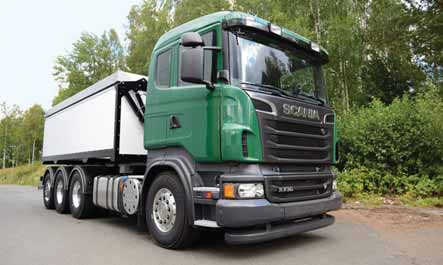 Swerock, Northland Resources’ general contractor responsible for transporting up to 5 million mt/y of iron
Swerock, Northland Resources’ general contractor responsible for transporting up to 5 million mt/y of iron
ore concentrate from the Kaunisvaara mine in northern Sweden to railhead loadouts, selected a fleet of
Scania R-Series trucks to handle the job.
Long-distance Hauling
Having been in the business for more than
100 years, Scania has a range of trucks
that are specially designed for use in min-ing and quarrying. Availability, fuel econo-my and high payload capabilities are all key
selling points for its vehicles, the company
says, pointing out that its trucks are built to
withstand tough mining conditions over a
long operational life, on- and off-road.
In addition, Scania can adapt vehicle
specifications to meet the environment at
individual mines, regardless of whether the
operation is tropical, at high altitude or in
the frozen north. Safety is also a key fea-ture, with its vehicle cabs having been
impact- and crash-tested to meet the
world’s toughest safety standards.
At the end of August, Scania
announced a SEK1.5-billion ($225-mil-lion) order to supply truck-and-trailer com-binations and service-related products to
the Swedish contracting company,
Swerock. As Northland Resources’ general
contractor, Swerock will use the vehicles to
transport up to 5 million mt/y of iron
ore concentrate from the company’s
Kaunisvaara mine in the far north of
Sweden to railhead loadouts, where the
material will be transferred to the rail sys-tem for delivery to the port of Narvik.
Optimized for a gross weight of up to
90 mt, the vehicles will run round-the-clock, with annual driving distances of
some 400,000 km. Scania’s contract cov-ers delivery of the trucks with specially
built trailers, driver training, vehicle moni-toring, and full maintenance and repairs on
the vehicles. To support the 80-strong
truck fleet, it is establishing a service
depot at Kiruna, and may have another at
Kaunisvaara in the future.
The vehicles being supplied are four-axle R-Series trucks, powered by a Scania
545-kW (730-hp) V8 engine. As part of its
agreement, Scania has undertaken to
meet a requirement that per-ton transport
costs must be cut continuously over a
nine-year period, based on performance
indicators for spending on fuel, tires,
repairs and maintenance.
Scania considers driver training to be a
critical part of a successful operation, with
good drivers using less fuel, and causing
less wear-and-tear to their vehicles and
the roads they drive on. Its driver training
scheme can help even the most experi-enced drivers to drive more economically
and safely, it says, with savings of about
10% on fuel plus a significant reduction
in emissions. In addition, tires will last
longer, and the powertrain will last longer
and consume less oil. In summary, Scania
says, a well-trained driver is far less likely
to be involved in an accident—meaning
less unplanned downtime and lower insur-ance premiums.
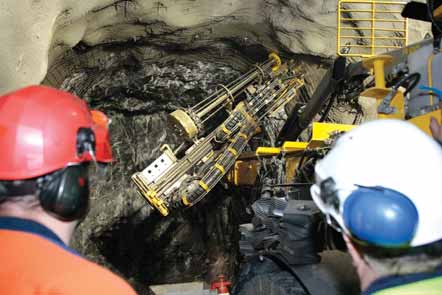 Outokumpu, operator of the Kemi chromite mine in Finland, uses a fleet of Atlas Copco underground drills.
Outokumpu, operator of the Kemi chromite mine in Finland, uses a fleet of Atlas Copco underground drills.
Because of the current mining boom, there is a shortage of skilled manpower in Finland, and while
Outokumpu has a training program for new operators, having sophisticated machines helps as well.
Drilling to Depth
From its background in drilling systems,
Atlas Copco has expanded its product
range over the years to include LHDs and
mine trucks, raiseborers, mobile crushers,
rock reinforcement systems and hydraulic
breakers, not to mention the ubiquitous air
compressors that carry its name. The com-pany’s most recent acquisition in the min-ing sphere was its takeover in February of
GIA Industri’s underground equipment business, which added a range of loading,
hauling, support and utility vehicles to its
portfolio, as well as ventilation systems.
Atlas Copco’s most prominent products
for surface mining, its Pit Viper large-diam-eter blasthole rigs, are made in the United
States, while mid-range rigs come from its
Swedish plants. In April, Atlas Copco
reported the award of a $37-million con-tract to supply PV351 rigs to Kumba Iron
Ore’s Sishen mine in South Africa, adding
to the 10 units already working there.
For this Nordic equipment review, Atlas
Copco has chosen to highlight the benefits
of using its GPS Rock Manager Control
System in a quarry-drilling application.
Drilling at the Angered aggregates quarry
outside Gothenburg is undertaken by the
Swedish contracting company, Skanska,
using a ROC D7C (now renamed as the
FlexiROC T35 R) rig.
For this application, where the granite
is both hard and fractured, Skanska uses
T45 drill rods and shank adapters together
with 76- and 89-mm drill bits, achieving
unexpectedly low consumables use. The
drilling software controls the process by
drilling in the right place, and feeding the
rods from a seven-rod cassette. With close
control over the feed pressure, the rig
achieves penetration rates of 1.1-1.6
m/minute and a rod service life of up to
26,000 m, Atlas Copco reports. Hole devi-ation has been cut to 10–50 cm per 20 m,
it adds, with holes being drilled 25–30 m
deep at 76-mm diameter.
Meanwhile, in the underground environ-ment, Atlas Copco has a fleet of drilling
equipment at Outokumpu’s Kemi chromite
mine in Finland, where capacity is current-ly being doubled to around 2.7 million mt/y
of ore. When this is achieved, Kemi will be
Finland’s largest underground mine, as well
as being the EU’s only chromite producer.
With the mine founded on resources
that will last maybe hundreds of years,
Outokumpu has a long-term perspective on
the operation in terms of the types of
equipment it uses, Atlas Copco says.
Because of the current mining boom, there
is also a shortage of skilled manpower in
Finland, and while Outokumpu has a train-ing program for new operators, having
sophisticated machines helps as well.
The first Atlas Copco machines arrived
at Kemi in 2003, with cooperation between
supplier and customer having directed the
way in which new systems have been intro-duced. Today, the mine operates an 11-strong fleet of the company’s machines,
including three Boltec rock-bolting rigs,
two Cabletec cable-bolters, two Boomer
development rigs, two Simbas for long-hole
drilling and another for cut drilling, and a
Diamec underground core-drilling rig.
The mine has a policy of working its rigs
for around five years, then replacing them
with more modern technology. Its most
recent arrival, a Boltec EC EH-DH rock-bolting rig, was delivered last December,
and is both electric- and diesel-powered.
Early observations showed that the
machine is capable of installing 120–130
bolts per shift, with the new heavy-duty
boom fitted to it helping to cut wear and
maintenance costs.
Cleaner Engines
Looking ahead to 2014, when the off-road
equipment industry must go from Tier 4
Interim/Stage 3B to Tier 4 Final/Stage 4,
Volvo Penta launched its new Tier 4i-com-pliant engine range at the beginning of last
year. In April, the company received com-pliance certification from MSHA and
Canmet for its 13- liter Tier 4i engines.
Meeting Tier 4i has been achieved
using selective catalytic reduction (SCR)
technology. For 2014, the company will
build on this by adding a “light” exhaust-gas recirculation (EGR) system that will
provide further emission reduction while
helping to keep the SCR catalyst operating
at an optimal temperature.
Volvo Penta’s Tier 4i range consists of
five basic engines, from the 5-liter D5 (105-160 kW) to the 16-liter, six-cylinder D16
(405-565 kW). The engines receiving certi-fication from MSHA, the 350-550 hp,
TAD13 60/61/62/63/64/65VE-series of
diesel engines offer ventilation rates
amongst the lowest in the industry for the
given power category, the company states.
With a ventilation rate of around 30 cfm/hp,
this is considerably lower than traditional
diesel engines used in mines today, it adds.
Since last year, Volvo Penta has had a
cooperation agreement with Sandvik to
supply engines for crushers, drilling rigs,
loaders and haulers. Sandvik notes that
while installing after-treatment systems
have proved to be a major issue for many
equipment builders, this has not been the
case with the Volvo Penta engines.
“This is just another regular engine
installation,” said Seppo Karhu, manager for
engine installations at Sandvik Mining, after
the first underground loader with SCR had
been developed. “With the SCR technology,
ventilation rates become so low that it is no
longer toxic emissions, but CO
2
or fuel con-sumption that sets the limits. And the Volvo
engines have low fuel consumption.”
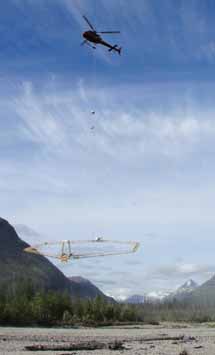 A SkyTEM TDEM airborne array has flown surveys
A SkyTEM TDEM airborne array has flown surveys
for several mineral exploration companies.
World-leading Exploration Equipment
Airborne Geophysics
Given the challenges of finding new min-eral deposits in northern European ter-rain, it is not surprising that Nordic com-panies have developed a range of highly
sophisticated tools to help exploration
companies in their search.
The Danish airborne geophysics com-pany, SkyTEM, reports that its time-domain electromagnetic technology
(TDEM) quickly and economically collects and delivers accurate, finely detailed
maps of the earth from the very near sur-face to depths of hundreds of meters.
Subtle variations in geology can be iden-tified, mapped and characterized in three
dimensions by detecting anomalies, thus
providing insights into the composition of
the soil, overburden and bedrock.
The company points out that this abili-ty is very valuable in the Nordic countries
where overburden often masks the primary
geology. Also, access to exploration sites
for ground study and positioning drills can
be challenging in rugged terrain, whereas
airborne surveys provide a fast and eco-nomical way to collect data.
Since 2005, SkyTEM has flown surveys
for several mineral exploration companies
in Finland, Sweden, Norway and Green-land, resulting in the discovery of a number
of previously unknown nickel, copper, iron
and gold prospects. In 2008, Nuna-Minerals used its technology to map pro-spective gold targets near Qussuk Bay in
west Greenland. SkyTEM provided an
accurate high-resolution data set that
made it possible to generate a 3-D model
of the property to depths of 250–300 m.
Last year, Taranis Resources filed min-ing claim applications on a copper-gold-cobalt-nickel exploration target that arose
from a SkyTEM survey in Finnish Lapland.
The 3-D geophysical inversions of the data
provided valuable information about the
geology. According to SkyTEM, its data
were very important since drilling any one of
the anomalies it revealed could yield a high-grade copper-gold deposit that would aug-ment the already known widespread, low-grade mineralization in the area surveyed.
New Concepts
In business since 1923, ABEM is one of
the world’s major manufacturers of geo-physical instruments. The company’s range
includes geo-electrical and seismic instru-ments, as well as vibration monitors.
As an example, the Terrameter LS is a
completely new concept in geo-electrical
equipment, the company says. The instru-ment allows data to be checked on site on
a large color screen that is extremely visi-ble in daylight. The instrument handles up
to 12 input channels for the highest possi-ble flexibility and productivity for 2-, 3-and 4-D measurements.
ABEM’s SAS LOG downhole probe con-nects to its Terrameter SAS 1000 or 4000
instruments, converting them to a logging
system for resistivity and IP. This means
that water-filled boreholes can be used to
correlate surface data, so giving a higher
degree of accuracy in the interpretation of
geophysical data. Back-pack portable, the system also measures the temperature and
SP down the hole, as well as indicating the
water level.
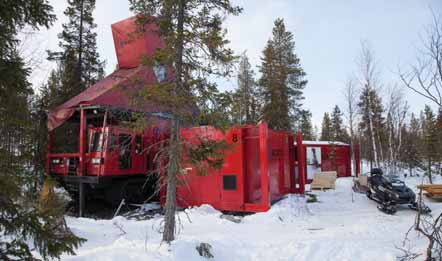 Finland-based contractor Oy Kati AB has carried out drilling programs in Finland, Sweden, Norway, Estonia,
Finland-based contractor Oy Kati AB has carried out drilling programs in Finland, Sweden, Norway, Estonia,
Greenland and Morocco.
Consultants and Contractors, at Home and Overseas
Drilling Experience
Oy Kati Ab Kalajoki (Kati) is a privately
owned Finnish drilling contractor with
more than 30 years’ experience in dia-mond core drilling. Most of its clients are
in mining and exploration, although it does
provide services to other industries.
The company points out that it was the
first drilling contractor in Europe to be
accredited to the ISO 14001 environmen-tal management system, reflecting its good
approach to working in environmentally
sensitive areas.
Kati has carried out drilling programs in
Finland, Sweden, Norway, Estonia, Green-land and Morocco. Among its specialties
are extra-deep holes, which may reach to
more than 2,000 m. With extensive experi-ence in demanding conditions, the compa-ny is also familiar with special tasks such
as helicopter-assisted drilling or directional
drilling with different methods.
Kati says that its drilling equipment
represents ‘best-in-class’ standard, being
able to succeed in a range of work condi-tions in reasonable time. New innovations
and continuous improvement, both in
drilling technology and methods of work,
make it a pioneer in its field, the company
adds. Its drilling machines are Sandvik DE-series, tailored in its own workshop to suit
various drilling purposes.
In addition to drilling, Kati also under-takes deviation surveys to determine the
location of drill holes in 3-D, and can offer
a very wide range of survey instruments to
meet the highest accuracy standards.
Managing Projects
PRiMAB (ProjektResurs i Malmfälten AB)
provides project and site management serv-ices to the mining industry, primarily in the
Nordic countries. In project management,
the company carries out customer-specific
assignments in areas such as project
design and construction management, the
coordination of work environment issues,
and technical documentation. For site
management, services include planning,
control and follow-up for aspects like con-struction-project accommodation, road and
storage management, heating and tempo-rary power supplies, waste management
and incoming and outgoing transport.
The company reports that its client
base has included Boliden, LKAB and
Northland Resources. As an example, it
was responsible for project management of
the new water system during the recent
expansion of Boliden’s Aitik copper mine,
including 36 km of pipelines, seven pump
stations and a waste-treatment plant. It
has also provided project coordination for a
new pump station at the bottom of the
Aitik pit, capable of handling 2,940 m3/h
over a 400-m static head.
Greenland Focus
A major Nordic construction and civil
engineering company, Denmark-based MT
Højgaard also has extensive experience
with drilling program in Greenland, noting
that it has had great success with core
drilling through the inland ice at the Isua
iron ore exploration project. Specially pro-duced equipment combined with its knowl-edge of Arctic conditions contributed to a
great season in 2011, the company said.
While MT Højgaard has been present in
Greenland for more than 50 years, 2011
was the first year that it had put its Arctic
expertise to use in the field of core drilling.
Its initial contract was to drill around
2,500 m, but less than a month into the
program, its client asked it to provide a sec-ond drill rig; by the end of the season, it had
completed around 7,000 m. The company
explains that on most holes, it had to drill
through 100–150 m of ice first, although
on one set-up it managed to drill through
300 m of ice before hitting bedrock.
Other projects undertaken in Greenland
have included establishing and operating
the Fiskefjorden olivine mine from 2005 to
2008, carrying out geophysical surveys for
Quadra FNX Mining (now KGHM Inter-national) at its Malmbjerget project, con-sultancy and site investigations for the
Tanbreez rare-earths project for Rimbal Pty,
and exploration work and camp manage-ment at Jiangxi Zhongrun Mining Co.’s
Carlsberg Fjord copper prospect in Jameson
Land, on the east coast of Greenland.
International Logistics
Also from Denmark, GlobeFLX
is an inter-national logistics company, buying as well
as transporting heavy and/or customized
goods. It has sub-offices in Dubai, the U.K.
and the United States, with important mar-kets in Europe, the C.I.S., the Middle East
and North and South America. It also
makes it its business to deliver effectively
and punctually to dangerous destinations,
or destinations where other obstacles stand
in the way.
The company offers 15 years of experi-ence in buying and moving equipment, such
as for the mining industry. Its customers are
international mining, oil and industrial com-panies, together with humanitarian organi-zations and NGOs that need equipment
moved to tough locations in the world.
The types of equipment that GlobeFLX
can supply include vehicles, trucks and
buses, materials-handling equipment, spe-cial-purpose vehicles, generators and light
towers, tires and batteries, and spare parts.
“We are seeing a continuous need for our
vast product portfolio—whether it is heavy
trucks, heavy equipment in general, spare
parts or the like. This is an area we focus on
and continue to develop in order to comply
with the constantly changing needs and requirements from our mining customers,”
said the company’s CEO, Jørgen Kildegaard.
In a recent commission, GlobeFLX has
sourced 10 right-hand-drive vehicles for a
mining customer in Western Australia,
which meant having left-hand-drive models
specially rebuilt. In South America, mean-while, the company is handling various
requests for used building and construction
equipment, again for mining-sector clients.
Mine and Tunnel Specialist
Bergteamet AB is one of Europe’s main
underground mining contractors. Founded
in 1999, the company has expanded to han-dle major projects within Sweden and inter-nationally, with a clear focus on utilizing the
latest technology in its operations. Its busi-ness is organized into four divisions: raise-boring, mining and tunneling, electrical,
and equipment design and construction.
Its raiseboring division is now a major
international contractor, having successful-ly completed a number of assignments in
countries such as India, Argentina, Chile,
Ireland, Spain, Austria and Iceland, as well
as in Sweden. Meanwhile, its Electro divi-sion supplies mining and other companies
with mobile power, power installations and
power technology. However, the recent
mining boom has led to significant growth
in its mining and tunneling division, which
is now its biggest business unit.
Earlier this year, the company complet-ed two access ramps, totaling 1,800 m,
from surface to the 230 m level at the
Dannemora iron mine in Sweden, and last
December, it signed a five-year contract
with Hindustan Zinc to raisebore a number
of ventilation shafts for its underground
operations in India. Previous contracts have
included drilling two long inclined vent rais-es at the Zinkgruvan mine in Sweden,
totalling 2,100 m, four raise bored vent
shafts at the Golden Grove operation in
Western Australia, and six vertical shafts at
Garpenberg, totalling 1,600 m and ranging
in diameter from 2.4 to 4.5 m.
Northern Experience
Arctic Drilling Co., based in Rovaniemi,
Finland, is both a core-drilling contractor
and a manufacturer of core-drilling rigs for
surface and underground applications. Its
customer base includes Agnico Eagle, Gold
Fields, First Quantum Minerals and Lapp-land Goldminers, as well as Boart Longyear.
The services offered include wireline
diamond drilling, RC drilling and borehole
surveys. ADC can also provide training for
operators of its equipment, together with
rig maintenance services.
Its M-series of underground drill rigs
come with either automatic or manual con-trol, wheels or rubber tracks, and optional
rod-handling equipment. The feed beam
rotates 360° horizontally and 180° verti-cally. Maneuvering between holes is easy,
the company says, with quick set-up times.
For surface drilling, the K-series rigs are
designed for easy operation, and are
mounted on an enclosed carrier on wide
rubber tracks. Drilling and sample han-dling is done inside the unit.
Nordic Resources
GeoVista AB is an independent geological
consulting company, headquartered in
Luleå. The company has carried out explo-ration work in Finland, Norway and Sweden,
and has in-house experience of exploration
in Central and South America and in Africa.
GeoVista can undertake geophysical, geo-logical and geochemical field work, as well
as interpreting data and identifying targets. It
can also provide exploration project manage-ment and drilling-supervision services.
The firm’s staff includes Qualified
Persons for reporting on mineral resources,
with GeoVista having prepared compliant resource estimates for companies such as
Scandinavian Resources, Dannemora
Mineral, Beowulf Mining, Riddarhyttan
Resources, Belvedere Resources and
Northland Resources.
Finnish Laboratory Network
With its headquarters in Espoo, Finland,
Labtium is an independent, accredited lab-oratory that offers mining and exploration
companies services that meet international
quality requirements and reporting practices. It has a comprehensive selection of
sample preparation and analytical methods
for the evaluation of mineral resources and
ore reserves that satisfy the requirements
of international reporting codes such as
Canada’s NI 43-101 and Australia’s JORC.
Labtium reports that it has a totally robot-ized sample-preparation line for explo-ration samples.
In addition to preparing and analyzing
exploration and grade-control samples,
Labtium can analyze process samples from
different stages of ore processing, includ-ing independent party and umpire analysis.
The company can also design and com-mission lab services for mining companies
to use themselves, or can provide out-sourcing services, either on-site or at its
five lab centers in Finland.
Geophysics Surveying
Although only recently established, Ageos
claims to have quickly become one of the
Nordic region’s leading geophysical survey
companies. Based in northern Finland, it
offers both traditional as well as highly
advanced geophysical survey and measure-ment services, both for ground geophysics
and borehole surveys. Its state-of-the-art
technology provides the opportunity for
identifying mineralization to depths of
1,900 m, Ageos adds, with its in-house
survey team collecting, analyzing and
interpreting high-quality data, using the
most advanced tools and techniques, and
delivering highly detailed, contrast-based
images.
Active mines that have used the com-pany’s services include Agnico-Eagle’s
Kittilä, where it completed several ground-and borehole-based survey projects during
2010 and 2011, and Inmet Mining’s
Pyhäsalmi. Here Ageos carried out several
deep TEM surveys, to a depth of 1,700 m.
Data and Information
At the end of last year, Sweden’s Raw
Materials Group (RMG) joined forces with
Intierra Resource Intelligence to form one of
the mining industry’s largest and most com-plete database groups. For 30 years, the two
companies have been a major source of
data, mapping, analysis and reporting for the
mining industry, providing resource-sector
intelligence for suppliers, financiers, govern-ments, exploration and mining companies.
Raw Materials Data, RMG’s proprietary data-base, is the most extensive supply-side data-base in the industry, the company claims.
Today, IntierraRMG delivers respected
market and project reports for suppliers,
material flows analysis, mineral economics
policy and consulting expertise. Its data-bases and sector-specific modules offer
insights into tenement ownership, compa-ny evaluations, mergers and acquisitions,
risk management, due diligence, competi-tor intelligence and project pipeline evalu-ation. The mapping division distributes
more than 850,000 maps globally through
leading industry publications and major
conferences, noting that maps are the
most effective marketing media to reach
mining and exploration companies.
Pumps and Pipes for Fluids Handling
Specialist Piping
KWH Pipe offers expertise in transporting
and storing liquids, gas and wastewater.
Active in Europe, North America and
Southeast Asia, its recent customers include
Talvivaara, KGHM, Boliden, LKAB, Karlesky
Okatysh and Highland Valley Copper.
The company’s product range includes
HDPE pressure pipe systems up to
1,600 mm outside diameter, gravity systems,
tanks and inspection chambers. It also offers
WehoSlurry abrasion-resistant pipes, as well
as conductive and chemical-resistant pipes,
having supplied heap-leaching systems, raw-water pipelines, and slurry pipelines, intakes
and outfalls for the mining industry.
A recent turnkey project involved the
supply of 1.2 km of floating pipes as part
of a 7 km-long system to drain water from
LKAB’s Leveäniemi open-pit near Kiruna.
The 18-month project involves pumping
some 30 million m
3
of water, with the
pipes initially floating on the surface as the
water drains, then eventually settling along
the deepest part of the truck route as the
water level drops. KWH Pipe reports that it
was the only contractor able to present a
preliminary plan for the project.
Steel Pipes for the World
Having celebrated its 60th
year in business
in 2011, Alvenius
is one of the best-known
names in the industrial pipe industry world-wide. It has supplied galvanized pipe and
fittings for carrying compressed air and
water to mines on every continent, and
since the development of thermoplastic
(TP)-coated pipes in the 1990s, it has
expanded its use range to include leaching,
dewatering and corrosive fluid applications.
Alvenius supplies two hot-dip galva-nized pipe systems, Victaulic and K10, in
diameters from 48 to 508 mm (2-20 in.).
Victualic is a grooved system for pressures
up to 80 bar (1,160 psi, while K10 is a
shouldered system for pressures up to 25
bar (360 psi). Its TP pipes, coated both
inside and out with thermoplastic, are
joined using Alvenius quick couplings or
flanges with diameters in the range
89–508 mm (3-20 in.).
Example deliveries that the company
has made to mines over the years include
48-152 mm pipes for air and water to the
Zambian copperbelt, 76–254 mm pipes to
Store Norske in Svalbard, and 100 km of
152 mm pipe for process- and drinking-water handling to ENOR’s Tirek and Amesmessa gold mines in Algeria. Alvenius has also been a long-term pipe supplier to the base-metal mining industry in Ireland.
Submersible Pumps
Grindex has been making submersible pumps since the 1960s,
since when its product range has expanded significantly, in terms of
both capacities and handling capabilities. One of the major advan-tages of Grindex pumps is their ability to run dry, the company says.
The 12-model Drainage range is designed for all kinds of dewa-tering, with capabilities running from 4 liter/s to a height of 11.5
m for the Micro to 150 liter/s to 105 m for the Mega. In high-lift
version, the Mega can handle 60 liter/s to a height of 230 m.
For sludge handling, there is the four-model Sludge range, while
the eight-model Bravo range is designed for dredging sedimentation
sumps and handling heavy slurries. There is also a six-model range
of stainless-steel pumps for handling corrosive fluids (Inox). Grindex
also supplies versions of nine of its submersibles that are MSHA-approved for use in potentially gassy underground environments.
Grindex reports that following the installation of two of its Inox
pumps at Codelco’s El Teniente copper mine in Chile, handling
rates of highly acidic water more than tripled compared to the pre-vious pumps used, while availability was also higher and costs
reduced by introducing a preventive maintenance schedule.
Light Pipes
Svebra Lightweight Piping not only produces hot-dip galvanized
steel pipes, but has also developed a range of aluminum piping for
use where extra low weight is needed. For instance, a 5.8-m length
of 102-mm-diameter aluminum pipe weighs just 10.5 kg, while
152 mm-diameter pipe of the same length weighs 22.5 kg.
Aluminum piping has a 30 bar pressure rating.
The company offers two quick-coupling systems for its galva-nized piping: Svebra and Victualic, which are approved for pres-sure up to 40 bar and 65 bar respectively. Piping and fittings are
supplied in diameters from 48 to 203 mm for Svebra systems, and
89 to 273 mm for Victaulic. Polythene-coated piping is also avail-able for corrosion-prevention in buried applications.
Svebra exports its products worldwide, including for pressure-and hydraulic systems in mining.
 Wassara’s water-powered W100 DTH drill lies in the middle of the company’s size
Wassara’s water-powered W100 DTH drill lies in the middle of the company’s size
range, which covers hole-diameter capabilities of 82 to 165 mm (3
1
⁄4 to 6
1
⁄2 in.).
Drilling Equipment for Accuracy and Economy
Water Power
Aside from being present at this year’s MINExpo, the specialist
DTH drilling-equipment manufacturer, Wassara, has plenty to occu-py it at the moment. In addition to moving to a new production
plant in Stockholm, the company is changing its name to LKAB
Wassara AB, although the product name will remain ‘Wassara.’
Wholly-owned by LKAB, Wassara is the world’s leading supplier
of water-powered DTH/ITH drilling systems. For production-hole
drilling, Wassara’s range includes the W70, W80, W100, W120
and W150 hammers, with hole size capabilities covering 82–165
mm (3¼–6½ in.). Major advantages claimed for the system
include greatly increased directional accuracy, especially over long
holes, and markedly lower energy costs, since high-pressure water
pumps are more efficient than air compressors.
Increased accuracy over greater hole
depths means that sub-levels can be
spaced further apart, Wassara points out,
which in turn saves substantially on devel-opment costs.
Wassara also offers its water-powered
slot-drilling system, which allows for burn-cut slots up to 40 m long to be formed from
a set of accurately located parallel holes.
Directional Control
Based in Melhus, Norway, Devico has more
than 20 years experience with directional
core drilling and borehole surveying. The
company has developed a range of instru-ments including directional core barrels,
core-orientation equipment, and both mag-netic and non-magnetic downhole survey
instruments. Devico claims to be the glob-al market leader in providing directional
coring services directly, and via its agents
and subsidiaries world-wide.
Devico launched its DeviDrill direction-al core drilling system in 1988, since when
it has been used in more than 40 different
countries, the company says. A wireline
version followed in 2001, allowing contin-uous measurements and core sampling
during steering.
Enabling sidetracking to be carried out
without using cement, plugs or wedges,
the DeviDrill uses a normal drill string
and is fully compatible with the N-size
wireline system. Devico’s survey tools are a
fully integrated part of the tool, taking
measurements while drilling is in progress.
Data are stored inside the tool and down-loaded wirelessly to a PDA after each run.
A major advantage of the system is the
reduction in drilling needed, especially
where deep orebodies are being sought,
the company notes.
Hydraulic Drills
From its plant in Nokia, Finland, Doofor
has been producing hydraulic rock drills
and spare parts since 1993. The company
states that its drills use its own high-fre-quency technology, which allows fast pen-etration with less strike force. This mini-mizes stress on the drill tools and maxi-mizes hole straightness, it adds.
It also invented the trapezoidal piston
design used in its machines, which gives
faster drilling by improving the movement
of the strike impulse in the drill rod. Its
product range includes machines generat-ing between 5 and 22 kW, suitable for hole
diameters of 36 to 127 mm (1⅜-5 in.). Its
larger rock drills also have a double damp-ening system to minimize stress to the
shank adapter or striker bar.
For light drilling applications, the com-pany can supply an aluminum alloy feed
beam that can be used with drills weighing
up to 75 kg.
Expanded Range
Robit Rocktools is one of the world’s major
suppliers of threaded bits for drilling in
mining, quarrying and construction. All of
its bits are manufactured from fully recy-clable steel that has, the company says,
more uniform properties and better fatigue
strength. The company’s acquisition last
year of a holding in the Korean rock-tools
manufacturer, Young Poong CND, and
investment in a new factory there has
allowed it to expand its product range to
include rods, shanks and couplings.
Both standard and retrac bit body
designs are available, as are different bit
faces designs to handle specific rock con-ditions, and a choice of button insert pro-files. For drifting and tunneling, Robit’s
button-bit range covers the R25, R28, R32
and R35 thread sizes in diameters from 33
to 76 mm. For bench and production
drilling, it offers bits for C38 to CT68
thread configurations, in diameters from 55
to 152 mm, while its reaming bit range
runs from 76 to 102 mm hole diameter.
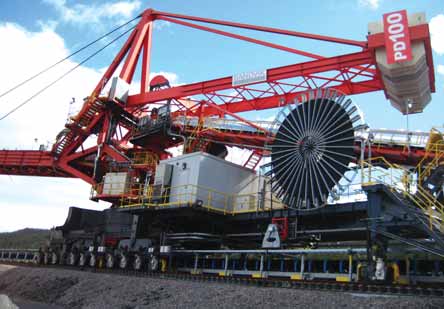 Cavotec power transmission, distribution and control technologies are used by many OEM products,
Cavotec power transmission, distribution and control technologies are used by many OEM products,
including this
Sandvik stacker-reclaimer.
Power, Drives and Controls
Providing Power Links
Cavotec produces power transmission, dis-tribution and control technologies that form
the link between fixed and mobile equip-ment. Its mining sector products include
motorized and spring-driven cable reels,
power connectors, radio remote controls,
cables and hoses for OEMs such as Sandvik
and Atlas Copco. Recent orders from
Australia for power-supply equipment have
included cable-reel systems for stacker-reclaimers and hopper cars, while in the
United States, Cavotec is supplying
ThyssenKrupp with specialized medium-voltage cables, hose reels and related
equipment for indoor stacker and reclaimer
machines at an application in Saudi Arabia.
In another major project with Sandvik,
Cavotec has an order for large level-wind
cable reels and special cable for coal-handling stacker-reclaimers in British
Columbia. The company is also supplying
power units, transformers, junction boxes,
plugs/sockets and mining cable to Agnico-Eagle’s Kittilä gold mine in Finland, to extend
the 690 V network that provides power for
equipment such as drill rigs. Also in Finland,
it has supplied 6.3 kV connectors and power
units for the electric mining excavators at
First Quantum’s Kevitsa nickel project.
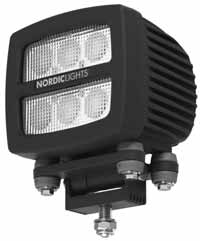 Nordic Lights designs its illumination products
Nordic Lights designs its illumination products
for
harsh service with a particular focus on
vibration
damping for higher reliability and
service life.
Heavy-duty Lighting
Nordic Lights designs and manufactures
LED, HID (Xenon) and halogen work lights
for the heavy-duty on- and off-road indus-tries. The company says that no matter how
good the light source and output—if equip-ment lights cannot handle the environment
they are used in, they are useless. Since
mining vehicles and machines are often used under extreme conditions, their lights
are also subject to shock and vibration.
Because of this, work lights need good
vibration dampening.
This need, it adds, is even more impor-tant today since LED and HID (Xenon)
work lights are heavier than the old halo-gen lights. They are also more valuable, so
it makes economic sense to invest in
durable solutions.
The company designs dampening sys-tems that respond to the specific vibration
patterns present—high-frequency from
engines, or low-frequency from loader-bucket impacts.
Vibration and shock resistance is also
applied to cables and other components,
as well as the light itself. It selects damp-ening materials that are suitable for the
intended working environment, while tak-ing the effects of wear, heat, cold, dust,
water, chemicals and fuel into account.
Extensive testwork is used to prove their
effectiveness, and to show that any break-age in use will not affect the vehicle’s elec-tronics or cause fires.
aa
Weighing on Wheels
At a time when more off-road trucks and
haulers are in operation at mines and quar-ries, the need for on-line material-flow
information is also increasing rapidly. In
response to this demand, the Tamtron
group has developed a robust and reliable
dumper scale with various ways to transfer
data wirelessly and on-line.
Tamtron’s DV dumper scale consists of
two axle load cells that replace the rear pins,
a pressure transducer and an advanced dis-play instrument, designed for on-board use.
Weighing takes place simply by lifting the
truck body, with inbuilt angle compensation
ensuring that weighing is accurate on
uneven ground. The scales can be installed
on any off-road truck, the company says,
including underground haul trucks.
The scales are equipped with a full-color touch screen, with both the display
and keyboard being illuminated to allow
round-the-clock use.
As weighing takes place on board, the
truck does not have to make trips to a weigh
bridge, with load data being stored in the
system’s memory. This can then be down-loaded either conventionally or over the
internet, with the ‘i-Stock’ option able to dis-play material balances at various locations.
AC Drive Specialist
Vacon claims to be the world’s largest com-pany concentrating solely on AC drives,
with around 5% of the global market. Fuel
economy and automation control are just
two of the advantages of using variable-speed AC drives in mining and minerals
processing, the company says, with the
technology offering energy savings of up to
50% when operating pumps, fans, com-pressors and winches. AC drives also make
much less noise than hydraulic alterna-tives. In applications needing braking,
Vacon’s active front-end units can feed
brake energy back to the mains.
Vacon’s product portfolio includes air-and liquid-cooled units, common DC bus
components, inverters and step-up medi-um-voltage equipment. Liquid-cooled AC
drives are ideal for use in underground
mining, it states, with the units being pro-tected against dust and humidity.
Vacon has delivered AC drives to com-panies such as LKAB in Sweden, Talvivaara
in Finland, Western Areas in Australia and
Metal Constructions of Greece. Talvivaara
uses hundreds of its drives to control AC
motors running pumps, fans, screws, con-veyors, feeders and mixers. At Western
Areas’ Cosmic Boy nickel concentrator in
Western Australia, Vacon drives control a
wide variety of pumps for process flow and
pressure control.
Vacon’s most important showcase in
conveyor applications has involved sup-plying AC drives to control 61 belt sta-tions at the Kardia and Mavropigi lignite
mines in Greece.
Using an AC drive for conveyor control
allows the speed to be adjusted to chang-ing needs, cutting energy costs and com-ponent wear while helping to improve
process control. In addition, soft starting
conveyors with AC drives reduces the stress
on gearboxes.
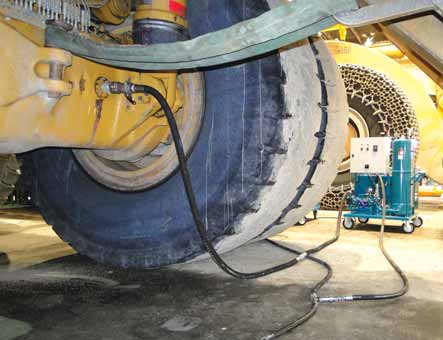 Deep-cleaning wheel motor and differential oils during regular servicing helps oils and components last
Deep-cleaning wheel motor and differential oils during regular servicing helps oils and components last
longer,
according to fluids filtration specialist C.C. Jensen.
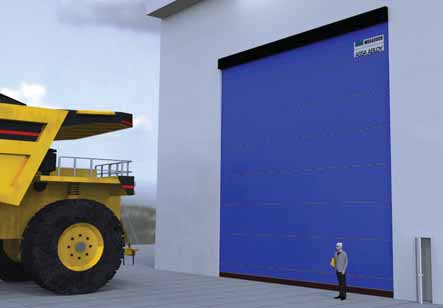
Assa Abloy Entrance Systems, supplier of heavy-duty workshop doors for 40 years, offers models
designed to cope
with heavy wind loads, cold weather and a dusty environment.
Specialized Products and Services
Cleaner Wheel-motor Oils
C.C. Jensen specializes in off-line oil filtra-tion, and states that effective depth filtra-tion is the key to maintaining oil used in
hydraulic, motor, gear and other systems.
The company says its research and experi-ence shows that effective, off-line oil filtra-tion can extend equipment lifetime by up
to six times or more, resulting in less down-time caused by oil contamination. All of its
filters are environmentally friendly, cellu-lose-based, and custom-designed for any
oil volume or flow.
Jensen reports that field tests using its
new mobile flushing unit (MFU) on truck
wheel motors during servicing shows how it
can make used gear oil cleaner than new
oil, even when working in cold climates
such as northern Canada. Long-term tests
on wheel motors and differentials on
Komatsu, Caterpillar and Bucyrus equip-ment showed gear oil being cleaned to
below recommended cleanliness levels.
During planned service checks, the oil is
cleaned quickly by being drained from
the gearbox, then circulated repeatedly
through the MFU until clean. Not only does
this save on the cost of replacing the oil,
the company says, but it ensures that the
oil is refilled into a clean gearbox.
Other applications for CJC filtration sys-tems include crushers, excavators, equip-ment engines, mills and storage tanks for
both oils and diesel, where dusty conditions
and poor tank maintenance can lead to fuel
being contaminated before it ever reaches the
equipment or power generator that uses it.
Keeping Workshops Secure
Assa Abloy Entrance Systems supplies
entrance automation solutions under the
Megadoor brand name. The company reports that it has delivered doors to
smelters, the mining industry, shipyards
and aircraft hangars for the last 40 years.
A recent contract has been to supply
more than 40 doors to Northland Resources
for the buildings at its new Kaunisvaara iron
ore operation in northern Sweden. The
doors will be fitted to truck-repair shops,
dressing plants and ore-storage units, in
sizes ranging from 3.5 x 3.5 m up to
10 x 8 m. All of the doors have been de-signed for heavy wind loads, cold weather
and a dusty environment, Megadoor says.
Following production in the company’s
plant in Skellefteå, installation of the first
doors was scheduled to start in September.
Operating vertically, Megadoors do not
need bottom rails, and do not ‘steal’ inter-nal space from the building. They provide
a tight seal, so protecting the work envi-ronment inside, yet place little load on the
building structure. Other recent mining-sector installations include Oyu Tolgoi in
Mongolia and Peñasquito in Mexico.
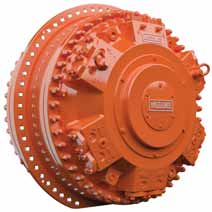 Hägglunds says its CBM hydraulic motor, shown
Hägglunds says its CBM hydraulic motor, shown
here,
offers 50% more torque in a package that
is smaller
and much lighter than its predecessors.
Drive Power
Launched during MINExpo 2012, the
Hägglunds CBM hydraulic motor is the
world’s most powerful direct drive, according to Bosch Rexroth. Taking over from the
Hägglunds Marathon motor, the CBM packs
50% more torque into a motor that is small-er and up to 50% lighter than its predeces-sor, the company says, adding that this gives
it the world’s highest torque-to weight ratio.
The CBM not only handles heavier
workloads, but also takes up less space
and places less weight on the driven shaft.
This means that machines, and in some
cases the facilities that house them, can
be smaller, lighter and simpler, Bosch
Rexroth says. The motor’s reduced installa-tion requirements and higher productivity
can mean lower overall investment, with
the hydraulic direct drive giving full torque
from zero speed, protection from shock
loads and four-quadrant operation.
Based on the Hägglunds CB platform,
the CBM has internal advances that allow it
to supply 6,000 Nm/bar of specific torque.
Direct retrofit kits are available for users
looking to upgrade from the Marathon,
making exchanging the motor both quick
and simple in existing machines. In addi-tion, the CBM has splines that simplify
attachment to the driven shaft, with
shrinkdisc adapters also available.
Generating World-wide
Wärtsilä Power Plants supplies flexible
base-load power plants operating on vari-ous liquid and gaseous fuels, together with
solutions for grid stability, reserve, peaking,
load-following and intermittent power gen-eration. The company’s power plants cover
the capacity range from 1 MW to more
than 500 MW.
Over the past year, Wärtsilä has won two
major contracts to supply power plants to
Australian mining operations. In August, it
received an order from Energy Develop-ments Ltd. for six 34SG engines running on
natural gas for Xstrata Zinc’s McArthur River
mine in the Northern Territory. With a com-bined output of 53 MW, the units should be
fully operational by the end of 2013.
This order followed another, gained in
July 2011, for 50 MW of dual-fuel gener-ating capacity for Fortescue Metals Group’s
Solomon Hub iron-ore operations in
Western Australia. The six 20-cylinder
34DF engines—the first to be installed in
Australia—use either natural gas or light
fuel oil. Wärtsilä notes that fast-track deliv-ery was a particularly important factor in
the award of this contract because of the
very tight project schedule.
Wear-resistance
Founded in 1978, SSAB is a world suppli-er of wear-resistant steel. At the end of last
year, it expanded its Hardox range to cover
thicknesses of 0.7–130 mm. “The mining
industry is an important and expanding
market for the thicker grades,” said Claes
Löwgren, the company’s business develop-ment director. The trend is for mining
machines to get bigger in order to increase
efficiency, so it is important that Hardox is
available in thicker versions that can keep up with this size development. Right now,
we are developing Hardox with thicknesses
up to 160 mm.”
SSAB reports that a member company
of the Hardox Wearparts network recently
delivered 350 mt of Hardox parts to
Sandvik for a new crusher plant in northern
Sweden. Although the 500 Brinell steel was
in high demand from other users, SSAB
was able to supply the tonnage, which the
company transformed into nearly 4,400
individual parts for the crusher project.
Another network member company in
Croatia has fabricated a 3.3 mt feeder unit
for a Zambian copper project, using Hardox
450 steel. Hardox 450 is an all-round wear-resistant plate with high toughness, plus
good bendability and weldability, SSAB adds.
Access Expertise
In 1957, Alimak introduced a new concept
in raise drilling: the self-contained raise
climber, which enabled drillers to work in a
much safer environment that had previously
been possible. Today, Alimak Hek has built
on the rack-and-pinion concept for person-nel and materials handling, having delivered
over 30,000 elevator systems to construc-tion and industrial projects world-wide.
Alimak states that its elevators offer a
good solution for underground as well as
surface applications such as pelletizing
plants, smelters, concentrators and other
ore-processing plants. Its wire-rope hoist is
suitable for carrying heavy loads at relative-ly fast speeds and is the primary means of
vertical access for men and materials in an
underground mine. Meanwhile, its rack-and-pinion elevators are ideally suited for
providing the secondary, emergency vertical
access required by mine safety regulations.
Elevators can be installed easily under-ground, it says, with lower costs than if a
machine room were needed. Alternatively,
in crushing plants, where the operator has
to control equipment on different levels, an
Alimak elevator may be a good option for
moving quickly from place to place.
Teaching Operators
Oryx Simulations works with OEMs in the
mining, forestry, construction and other
industries to produce simulators for opera-tor training. However, using a simulator is
not just about optimizing and improving
operator training, Oryx points out, since it
is also about health and safety at work,
helps to eliminate costly mistakes and
allows operators to train on dangerous and
unusual situations, without injury risk.
At the end of last year, the company
launched three new simulator packages,
focusing on Atlas Copco’s L8, D65 and
PitViper drill rigs to add to the underground
and surface drill-rig simulators already on
offer. All three are equipped with a fully
functional Atlas Copco cab, with or without
the company’s RCS system. Other Oryx
simulators include Volvo CE wheel loaders
and excavators.
Each training program includes a num-ber of exercises, from basic maneuvering to
more advanced tasks. The difficulty
increases step-by-step, ensuring that the
operator knows the basics before facing
more challenging exercises.
Fighting Fire with Fog
Few things are more unpredictable, or haz-ardous, in mining than equipment fires,
especially when these occur in confined
spaces. Fogmaker International’s fire-sup-pression system is designed to create a
water mist over a fire, depriving it of oxygen
and cooling the smoke gases and hot parts
of the engine.
Fogmaker has developed a high-pressure
extinguisher that functions like a piston
accumulator. When activated, the high pres-sure and the use of special spray nozzles cre-ates micro-drops with an average size of 5
µm. These are instantly vaporized by the
heat of the fire, so that 1 liter of water cre-ates 1,700 liters of water mist. The rapid
heat absorption achieved enables the
Fogmaker system to provide enough cooling
to put the fire out quickly and reduce the risk
of re-ignition. The water mist also includes a
foam additive to cover the flammable oil
products that tend to collect in engine trays.
The company’s systems are available for
a whole range of mining machines, as well
as for other commercial and industrial
applications.
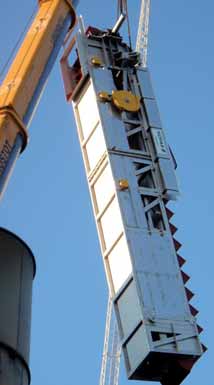 Kopar supplied a bucket elevator, shown here, as
Kopar supplied a bucket elevator, shown here, as
part of
a nickel slag handling system at Boliden’s
Harjavalta
smelter in Finland.
Mineral Processing and Materials Handling
Smelter Focus
Kopar has extensive expertise in equipment
and services for non-ferrous smelters, as
well as many other applications. The com-pany designs and manufactures rotary and
steam dryers, converters, anode furnaces,
granulation plants, bucket elevators,
mechanical and pneumatic conveying sys-tems, and rotor and roller crushers. It also
offers engineering and other services
including pilot tests, project management,
erection, start-up, training, modernization,
and spare and wear parts.
Earlier this year, Kopar supplied and
installed a nickel slag-handling system at
Boliden’s Harjavalta smelter in Finland.
The contract included supplying a bucket
elevator, its elevator tower and a new belt
conveyor, as well as removing the two older,
shorter elevators that were being replaced.
The bucket elevator is used for dewa-tering nickel slag, with a nominal lifting
capacity of 110 m
3/h of wet slag at 20%
moisture. The elevator is 14 m long with
forged and hardened double drag chains,
while the belt conveyor is 36 m long with
the same capacity.
In the past Kopar has delivered various
pieces of equipment to the Harjavalta
smelter, including a Peirce Smith converter
for the copper-smelting line and pneumatic
conveying systems for copper concentrate.
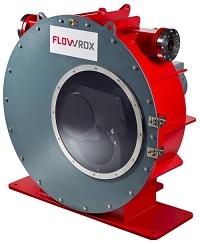 Flowrox recently developed the largest hose
Flowrox recently developed the largest hose
pump in
the world. Its LPP-T100 can deliver
up to 31 liters of
material per revolution.
Pumps for Tough Jobs
Flowrox
has provided valves and pumps for
high-wear and aggressive processes in
more than 50,000 installations in mining,
metallurgy and mineral applications
around the world. Applications include
grinding and screening, hydrocyclone sep-aration, magnetic separation, flotation,
thickening, filtration, tailings handling and
systems such as sampling, dosing and
water treatment.
Its automatic and manual pinch valves
are used for shut-off or control applications
involving abrasive or corrosive slurries,
powders or coarse materials, while its
heavy-duty knife gate valves are used in
processing wet or dry media with a design
that ensures no downstream leakage.
Meanwhile, Flowrox’s peristaltic and pro-gressive cavity pumps are designed for use
in processes involving industrial transfer,
and the dosing and metering of abrasive,
corrosive, and other demanding slurry
duties. Its check valves are used in back-flow, flood, and odor-control applications
involving abrasive and corrosive media.
In June, Flowrox launched the largest
hose pump in the world, the LPP-T100,
which can handle up to 100 m3
/h at pres-sures up to 10 bar. Using Flowrox’s roller
design, the pump delivers 31 liters each
revolution, with the company saying that
thickener underflow is a good example of
an application for the new pump. The
design of these hose pumps eliminates
friction, maximizes hose life time and low-ers energy consumption, Flowrox adds.
In 2008, Flowrox supplied 400 auto-matic pinch valves to Gulf Industrial
Investment Co. for its second iron ore pel-letizing plant in Bahrain. The pneumatical-ly actuated 100-150 mm valves are oper-ating in the pellet-coating and iron-ore
slurry lines as well as in various side appli-cations, and apart from the control valves,
have been working for three years without
needing sleeve changes, Flowrox says.
It has also supplied 12 LPP-T 65
pumps for washing-liquid circulation duties
to the Talvivaara nickel mine in Finland,
handling water recycled from the filtration
units. This wash water typically has a very
high solids content, which is why hose
pumps were chosen for this application.
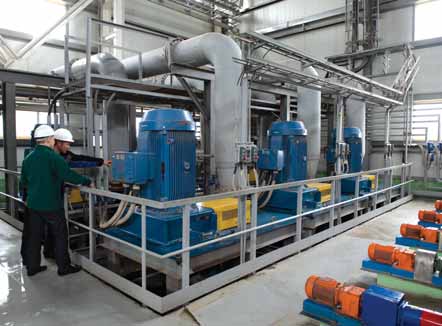 Metso recently supplied Russian iron ore producer KMARuda with six Sala VSMM350 vertical slurry pumps,
Metso recently supplied Russian iron ore producer KMARuda with six Sala VSMM350 vertical slurry pumps,
dramatically extending pump life in this application while reducing energy costs by almost a third.
Safer Mill-liner System
According to Metso, its new Megaliner Poly-Met shell liner maximizes mill availability
while improving worker safety, with rub-ber/metal composite sections weighing up to
60% less than similarly sized metallic liner.
Mill availability is improved through faster
liner replacement since Megaliner uses larg-er-than-average sections that can still be
placed with the same 6- to 8-axis liner-han-dlers used with many large autogenous
grinding (AG) mills. In terms of safety, liner
sections are bolted into position from out-side the mill, so workers do not need to
stand in the potential ‘drop-zone’ inside.
The system is suitable for large AG mills
with large trunnions and where modern
liner handlers are available. Each Mega-liner element integrates multiple lifter and
shell plate rows, and covers an area of up
to 4 m
2
. The growing population of large
grinding mills and high utilization rates are
driving the demand for large, high-quality
grinding wear parts, and Metso points out
that using large-sized liner assemblies cuts
the number of pieces to be handled and
shortens maintenance shutdowns.
In August, the company announced a
€10-million investment in increasing its
rubber mill lining production capacity by
around 30%. The first set of new presses, in Metso’s plants in Chile, Sweden,
Canada, Mexico and Peru, is scheduled to
be in operation by the end of 2013, with
the upgrade due for completion in 2015.
A wear-parts optimization project that
Metso undertook for the Russian iron ore
producer, KMARuda, has led to a 30%
increase in grinding performance, the
company reports. KMARuda operates an
underground mine in the Kursk iron-ore
province in southwestern Russia, produc-ing 4.8 million mt/y of very abrasive
quartzite-hosted ore that is processed into
2.1 million mt of concentrate.
The operation now has a Nordberg
C140 jaw crusher fitted with Metso MX
jaws for high-wear applications. Secondary
crushing is done by a Nordberg HP200
and two HP500 cone crushers, using extra-thick XT720 manganese liners, with the
company getting up to 30% longer life
from its liners than before. Fines produc-tion has been increased, so less grinding is
needed, helping to increase throughput
and cut per-ton energy costs, Metso says.
Metso also supplied KMARuda with six
Sala VSMM350 vertical slurry pumps for
underwater use, which has extended pump
life from around 2,500 hours to up to
13,000 hours, as well as cutting energy
costs by 25%-30%.
Water-treatment Range
Kemira offers a range of chemical extrac-tion and process solutions for the mining
industry, where water plays a central role.
For example, its products for iron ore and
nickel processing include depressants,
coagulants, flocculants, dispersants, grind-ing aids, surfactants, defoamers, acids,
briquetting binders and modifying agents.
For iron ore beneficiation, where the
trend is toward processing lower-grade
ores, Kemira offers a range of organic
binders specifically designed for pellet
agglomeration. These help maintain pellet
porosity while helping with growth behavior
and resistance to deformation, as well as
giving cleaner pellet surfaces, the company notes.
Kemira’s products for nickel briquetting
are designed to improve the agglomeration
process as well as reducing dust from finely divided nickel. Compounds that can be
treated include nickel oxide, hydroxide, car-bonate, nitrate and basic nickel carbonate.
Water-treatment products include coag-ulants and flocculants for fines thickening,
dewatering and pond treatments, and latex
and surfactant products for dust control.
Bulk-handling Systems
ASM i Askersund designs and produces
equipment for bulk materials handling,
including crushing, screening, sorting, stor-age and transporting systems. Its client list
includes companies from Russia, Korea,
the U.K. and Ireland, as well as Sweden
and Norway, with commodities being han-dled ranging from iron ore to clays, kimber-lite, fuels, concentrates and aggregates.
The company’s largest order to date,
won in late 2010, has been to supply con-veying systems to Boliden for handling
materials at its new electronics scrap-recy-cling plant at the Rönnskär smelter.
ASM’s conveying system comprised some
bridge conveyors, different types of weigh-ing and dosing machines, hoppers and
buildings.
Flotation Reagents
Established in 1938 the Danish chemicals company, Cheminova, is an interna-tional producer of flotation reagents under
the Danafloat brand name. The company
has developed dithiophosphate mixtures
and mixtures of dithiophosphates with
mercaptobenzothiazole and thionocarba-mates which, it says, improve collection
performance.
Its process flexibility means that prod-ucts can be tailored to its customers’
requirements. It has a wide range of dithio-phosphate flotation reagents that are avail-able in acid and aqueous solution forms,
the latter using sodium, potassium or
ammonium hydroxide for neutralization.
Cheminova also supplies a full range of
xanthates and some frothers.
Conveyors for Northern Mines
Over the past few years, the northern
Finnish company, Paakkola Conveyors, has
won a number of contracts to supply mate-rials-handling equipment to some of the
major new projects in the Nordic countries.
For example, in 2010 it delivered a sub-stantial package of systems to Talvivaara,
including a 450-m-long bridge stacker-con-veyor, 6 km of overland belt conveyors car-rying 4,500 mt/h, a crushing system and a
crawler-mounted tripper car. The contact
covered engineering, fabrication, electrifi-cation, automation and installation of the
systems, with the stacker-conveyor and
crushing system using GPS positioning.
Having also won the supply contracts
for conveyor, transfer and take-up systems
for the Kevitsa mine, and nearly 5 km of
conveyors at Kaunisvaara, earlier this year
the company received two orders from
Boliden for its Garpenberg mine. The first
covers 750 m of belt conveyors and feeders
for concentrate handling, while the second
added five concentrate silos, five belt feed-ers and the support structures for them.
Paakkola Conveyors specializes in pro-ject management, the provision of convey-or systems with advanced technology, mod-ernization of existing systems and the sup-ply of aftermarket services.
High-intensity Technology
Outotecis one of the world’s foremost
providers of minerals and metals process-ing technology, as well as offering innova-tive solutions for the chemicals industry,
industrial water treatment and the utiliza-tion of alternative energy sources. Its prod-uct line covers the entire processing chain
and includes technologies for ferrous met-als and ferroalloys, alumina and alu-minum, copper, nickel, zinc, precious met-als, niobium, synthetic rutile, and various
industrial minerals. The company’s servic-es include spare parts, maintenance, plant
audits, modernization and debottleneck-ing, as well as operator training.
Outotec states that many of its solu-tions have been certified in the European
Union as best available techniques (BAT).
These include flash smelting and flash
converting for copper and nickel, zinc
direct leaching, electrolytic refining of cop-per, nickel and zinc, alumina calcination,
and sulphuric acid production. As exam-ples, half of the world’s pyrometallurgical
primary copper is produced using its flash-smelting technology, while its SX-EW sys-tems account for one-third of all electro-won copper.
At MINExpo, the company unveiled the
newest version of its HIGmill high-intensi-ty grinding mill for fine, ultra-fine and
regrind milling applications. The technolo-gy has been available for more than 30
years, and there are more than 260
installed units around the world, with mill
powers of up to 5 MW.
Outotec says the typical HIGmill appli-cation is for regrinding concentrates, with
the product fineness being controlled by
adjusting the shaft speed, since all
HIGmills are supplied with a variable-speed
drive system to give plant operators opti-mum process and particle-size control. The
particle-size distribution can be also meas-ured by an Outotec PSI on-line particle
analyzer, with the shaft speed being adjust-ed to maintain a constant product size.















